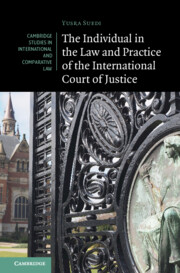Book contents
- The Individual in the Law and Practice of the International Court of Justice
- Cambridge Studies in International and Comparative Law: 192
- The Individual in the Law and Practice of the International Court of Justice
- Copyright page
- Contents
- Foreword
- Acknowledgements
- Table of Cases
- Introduction
- Part I The Individual in the Law of the International Court of Justice
- 1 Standing
- 2 Diplomatic Protection
- 3 Advisory Proceedings
- 4 Staff Members
- 5 Remarks on Law
- Part II The Individual in the Practice of the International Court of Justice
- Bibliography
- Index
- Cambridge Studies in International and Comparative Law
1 - Standing
from Part I - The Individual in the Law of the International Court of Justice
Published online by Cambridge University Press: 25 March 2025
- The Individual in the Law and Practice of the International Court of Justice
- Cambridge Studies in International and Comparative Law: 192
- The Individual in the Law and Practice of the International Court of Justice
- Copyright page
- Contents
- Foreword
- Acknowledgements
- Table of Cases
- Introduction
- Part I The Individual in the Law of the International Court of Justice
- 1 Standing
- 2 Diplomatic Protection
- 3 Advisory Proceedings
- 4 Staff Members
- 5 Remarks on Law
- Part II The Individual in the Practice of the International Court of Justice
- Bibliography
- Index
- Cambridge Studies in International and Comparative Law
Summary
The Court’s personal jurisdiction is governed by Article 34(1) of its Statute, limiting standing to states. Through an examination of the travaux preparatoires of this provision, it is revealed that while drafters considered granting individuals standing before the World Court, this was ultimately rejected due to reasons anchored in the traditional positivist doctrine. While scholars have long criticised Article 34(1) for being at odds with the role of the individual in the contemporary international legal order and called for its amendment, this chapter argues against this proposal due to the practical infeasibility with respect to Statute amendments, workload, jurisdiction, and legal interest. It argues instead that the Court may adjust its procedural mechanisms in a variety of contexts to circumvent its Article 34(1) and allow for the integration of concerned individuals in its proceedings to the best of its ability, where necessary or desirable.
Keywords
- Type
- Chapter
- Information
- Publisher: Cambridge University PressPrint publication year: 2025

